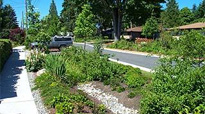Al Raby School for Community and Environment
Located in East Garfield Park, the heart of what might become Chicago’s “greenest” neighborhood, the Al Raby School for Community and Environment was confronted with a striking lack of open space. The front yard consisted of cracked and degraded cement paving.
With the help of CNT, in early 2007, the Al Raby High School began transforming the school’s physical environment into the optimal environmental leadership learning setting with the installation of a 1500 square foot native woodland garden. The school community, from teachers and students to local neighbors, helped create a garden that will improve the school’s appearance while simultaneously increasing its capacity to accomplish its educational mission. Named after the 2004 Nobel laureate Wangari Maathai in honor of her distinguished environmental work, the garden is helping to beautify the main entrance of the school and connect the students to a living ecology by providing a hands-on experience in landscape design, creation, and maintenance.
On September 20, 2007, at an intimate gathering at the Al Raby School, Dr. Wangari Maathai presided over the dedication of a native garden planted in her name. Students, teachers and community members listened as Dr. Maathai spoke of the essential role gardens like the Wangari Maathai Natural Garden play in promoting urban renewal, social and environmental activism and raising awareness—from the Al Raby School on Chicago’s West Side to the Green Belt Movement in Nairobi, Kenya.
The Wangari Maathai Natural Garden was made possible by funding from the Prince Charitable Trusts, and service and material donations from F.H. Paschen, Christy Webber Landscapes, Green Corps, the Chicago Park District, and the Chicago Bureau of Forestry.
Download the Project Fact Sheet (.pdf).
View the photo gallery.



